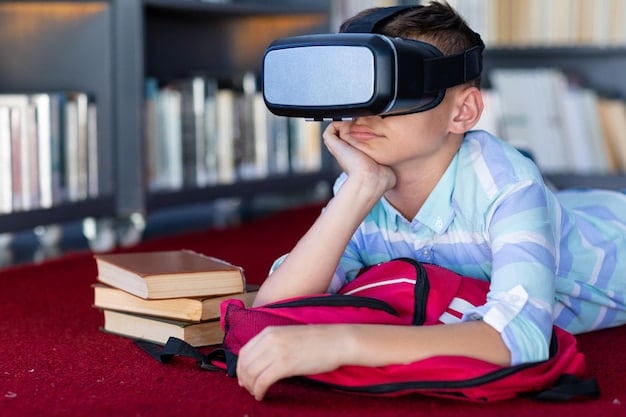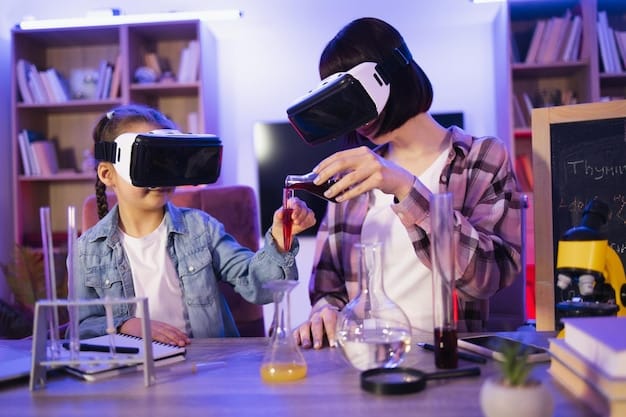Augmented & Virtual Reality in US Education: Transforming Learning

Augmented Reality (AR) and Virtual Reality (VR) applications in US education are revolutionizing teaching methods by offering immersive, interactive, and engaging learning experiences that cater to diverse student needs and enhance educational outcomes.
The integration of technology into education has opened up new avenues for learning, and Augmented Reality (AR) and Virtual Reality (VR) applications in US education are at the forefront of this transformation. These immersive technologies are changing how students learn, teachers teach, and educational institutions operate.
The Rise of AR and VR in Education
Augmented Reality (AR) and Virtual Reality (VR) technologies are no longer confined to the realms of gaming and entertainment. They are rapidly finding their way into various sectors, including education, where they promise to revolutionize the learning experience. In the US, schools and universities are increasingly exploring the potential of AR and VR to create more engaging, interactive, and effective educational environments.
These technologies offer unique opportunities to enhance traditional teaching methods, making complex subjects more accessible and easier to understand. By immersing students in virtual environments or augmenting their real-world experiences, AR and VR can cater to different learning styles and provide personalized educational content.
What is Augmented Reality (AR)?
AR enhances the real world by overlaying digital information onto it. Using devices like smartphones, tablets, or AR glasses, students can interact with virtual objects and information in their physical surroundings. For example, a history class could use AR to view a virtual model of the Roman Colosseum in their classroom.
What is Virtual Reality (VR)?
VR creates a completely immersive digital environment that replaces the user’s real-world view. Utilizing VR headsets, students can enter virtual classrooms, explore historical sites, or conduct scientific experiments in a safe and controlled setting. VR offers a high degree of realism and interactivity, making learning more engaging and memorable.

The adoption of AR and VR in education is driven by the desire to create more effective and engaging learning experiences. These technologies have the potential to improve student outcomes, foster critical thinking skills, and prepare students for the challenges of the 21st-century workforce.
Benefits of AR and VR in US Education
The integration of AR and VR into the US education system offers a multitude of benefits that extend beyond traditional teaching methods. These technologies have the potential to enhance student engagement, improve knowledge retention, and cater to diverse learning styles. Here are some key advantages:
These technologies are not just about making learning fun; they are about creating more effective and impactful educational experiences.
- Enhanced Engagement: AR and VR provide immersive experiences that capture students’ attention and make learning more enjoyable. By interacting with virtual environments, students become active participants in the learning process, leading to increased engagement and motivation.
- Improved Knowledge Retention: Immersive learning experiences have been shown to improve knowledge retention compared to traditional methods. When students can visualize and interact with concepts, they are more likely to remember and understand them.
- Catering to Diverse Learning Styles: AR and VR can cater to different learning styles, including visual, auditory, and kinesthetic learners. These technologies allow students to learn at their own pace and in a way that suits their individual needs.
- Accessibility and Inclusivity: AR and VR can make education more accessible to students with disabilities or those in remote locations. Virtual field trips and immersive learning experiences can be brought to students who may not otherwise have access to them.
By offering immersive, interactive, and personalized learning experiences, AR and VR can transform education in the US and prepare students for success in the future.
Applications of AR and VR Across Subjects
The versatility of AR and VR technologies allows for their application across a wide range of subjects, from science and math to history and language arts. These technologies can enhance the learning experience in various disciplines, making complex concepts more accessible and engaging.
These applications are not just about novelty; they represent a fundamental shift in how education is delivered and experienced.
Science
In science education, AR and VR can be used to visualize complex molecular structures, simulate scientific experiments, and explore the human body in detail. Students can dissect a virtual frog without the mess or travel to distant planets to study astronomy.
History
AR and VR can transport students back in time to experience historical events firsthand. They can walk through ancient Rome, witness the signing of the Declaration of Independence, or explore the Egyptian pyramids. These immersive experiences make history more engaging and memorable.

Many classrooms are finding that students are more excited to learn when AR and VR tech is involved.
AR and VR are powerful tools that can enhance learning across various subjects. Their ability to provide immersive, interactive, and engaging experiences makes them valuable assets in the education system.
Challenges and Considerations
While AR and VR offer numerous benefits in education, it is essential to acknowledge the challenges and considerations associated with their implementation. Addressing these concerns is crucial to ensure the successful integration of these technologies into the US education system. Some of these include costs, teacher training and accessibility concerns.
These technologies can bring excitement to the classroom, but the technology can be expensive.
- Cost: The initial investment in AR and VR hardware and software can be significant, making it challenging for schools with limited budgets to adopt these technologies.
- Teacher Training: Educators need proper training to effectively integrate AR and VR into their lesson plans. Professional development programs are essential to equip teachers with the skills and knowledge to use these technologies effectively.
- Accessibility: Ensuring that AR and VR experiences are accessible to all students, including those with disabilities, is crucial. Considerations should be made for students with visual or auditory impairments, as well as those with motion sensitivities.
By addressing these challenges and fostering collaboration between educators, policymakers, and technology providers, the US education system can harness the full potential of AR and VR to transform learning.
Future Trends in AR and VR Education
The landscape of AR and VR in education is constantly evolving, with emerging trends shaping the future of learning. As technology advances and adoption increases, we can expect to see even more innovative applications of AR and VR in the classroom. With students getting acclimated to the technology, education is getting more customized.
The possibilities with AR and VR technologies are boundless.
Personalized Learning Experiences
AR and VR can be used to create personalized learning experiences tailored to individual student needs and learning styles. Adaptive learning platforms can adjust the difficulty and content of AR and VR simulations based on student performance, providing a customized learning path.
Collaborative Learning Environments
AR and VR can facilitate collaborative learning by connecting students from different locations in virtual classrooms. Students can work together on projects, share ideas, and learn from each other in immersive, interactive environments.
The future of AR and VR in education is bright, with the potential to transform learning in profound ways. By embracing these emerging trends and addressing the associated challenges, the US education system can prepare students for success in the 21st century and beyond.
Examples of AR and VR Success in US Schools
Across the United States, numerous schools and educational institutions are already leveraging the power of AR and VR to enhance the learning experience. These success stories serve as inspiration for other educators looking to integrate these technologies into their classrooms. Technology isn’t just for the advanced, but helping bring education to everyone.
These success stories demonstrate the transformative potential of AR and VR in education. By embracing these technologies and fostering innovation, the US education system can create more engaging, effective, and equitable learning experiences for all students.
- History Classrooms: Schools across the US are using VR to immerse students in historical events. They can walk through ancient civilizations, witness key moments in history, and gain a deeper understanding of the past.
- Science Labs: AR is being used to create virtual science labs where students can conduct experiments without the need for expensive equipment or hazardous materials. Students can dissect virtual animals, explore the human body, and study complex scientific concepts in a safe and interactive environment.
- Special Education: AR and VR offer unique opportunities to support students with special needs. Virtual reality can provide a calming and structured environment for students with autism, while augmented reality can help students with learning disabilities improve their reading and comprehension skills.
| Key Point | Brief Description |
|---|---|
| 💡 Enhanced Engagement | AR/VR makes learning more enjoyable and captivating for students. |
| 🧠 Knowledge Retention | Immersive experiences improve memory and understanding of concepts. |
| 📚 Diverse Learning | AR/VR supports various learning styles, catering to individual student needs. |
| 🌍 Accessibility | Provides educational opportunities for students in remote areas or with disabilities. |
FAQ Section
AR enhances the real world with digital overlays, while VR creates a completely immersive virtual environment. AR uses devices like smartphones, whereas VR typically requires headsets.
AR and VR offer interactive and immersive experiences that capture students’ attention, making learning more enjoyable and fostering active participation in the educational process.
Subjects like science, history, and geography benefit significantly, as AR and VR can provide visual and interactive simulations that enhance understanding and retention of complex topics.
The main challenges include the high cost of equipment, the need for teacher training, and ensuring accessibility for all students, including those with disabilities.
Future trends include personalized learning experiences, collaborative virtual classrooms, and more sophisticated AR applications that adapt to individual student needs in real-time.
Conclusion
In conclusion, Augmented Reality (AR) and Virtual Reality (VR) applications in US education are poised to revolutionize the way students learn. By embracing these technologies and addressing the associated challenges, the US education system can create more engaging, effective, and equitable learning experiences for all students, preparing them for success in the future.





